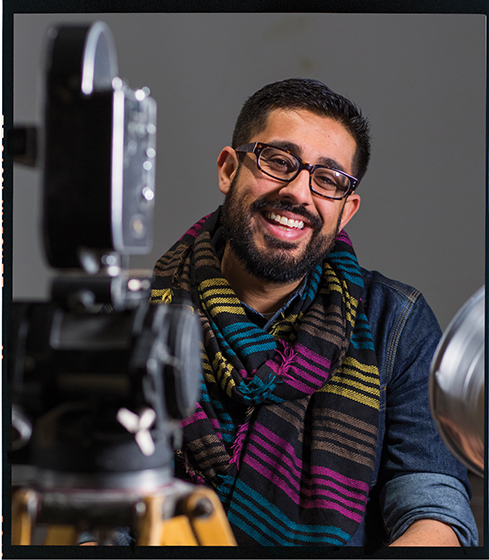 Spring 2016
Spring 2016|
Adil Mansoor
By his estimate, it was all those “checked boxes” that helped then-undergrad Adil Mansoor score a coveted spot as a campus tour guide at Northwestern University: “I’m a Pakistani- Indian. I was a queer-identified kid. I did a lot of theater. I went through the financial aid experience. I had an immigrant background.” But it’s likely his big personality had something to do with it, too. The theater artist and arts educator learned early on that his ability to command an audience—a tour group, a theater audience, a group of teenagers—could not only get him somewhere in life, but also allow him to do some good. Today Mansoor has no fewer than three jobs to help him fulfill that mission. He’s program director at Pittsburgh’s Dreams of Hope, a queer youth arts organization, where he directs young people in plays they write themselves. He’s a founding member of Hatch Arts Collective, a performing arts group committed to socially engaged work that recently produced and directed Chickens in the Yard, the first play staged by Quantum Theatre as part of its Gerri Kay New Voices Program. And for the past four years he’s been youth program coordinator at The Andy Warhol Museum, where he manages two of the museum’s big annual youth events: Youth Invasion, where kids from across the region plan programming and then take over the museum for a day, and Prom @ The Warhol for queer, trans, and allied youth, some of whom don’t feel they have a place at their own school proms. He also won a national award for Dine and Discuss, an afterschool program he helped create, where kids sat around tables at The Warhol, ate a meal, and talked about issues of culture and religion. Says Mansoor, “We want young people to be talking about this stuff.” When did you become interested in the arts?In the first grade—I have a really clear memory of it. They took the best two readers from every grade level to be in this all-school play, and I wasn’t one of them. So I petitioned the first-grade class to do a play so everyone who wanted to be in it could be in it. I played a groundhog that had a guinea pig sister, and I taught her how to juggle. It felt like a victory. I had my voice heard! At what point did equity and inclusiveness become so much a part of your work and your art?When I started to realize that I was an anomaly at Northwestern University. That I was unique for someone coming from my income experience to be at a school like that. I was in all of these education classes reading about the educational gap and looking at what income does to test scores, and I started to think a lot about who gets to go to college, and who gets to go to a school for the arts. It started to click that I might have the opportunity to shift that paradigm, even for a small 1 percent. Did you find Pittsburgh a welcoming place to do that kind of work?I found people here very willing to say welcome to new folks. The community is also really accessible in terms of getting projects supported, getting people interested, and building teams. One of the first places I made networks and friends was at the My People film series at the Kelly Strayhorn Theater. It’s an annual film series of movies for and by queer people of color. I could not believe that it was happening. I hadn’t even seen that in Chicago. The staff is super diverse and represents communities in a way I’m excited to see represented. Has a lot changed in high schools in terms of kids being able to embrace their identities sooner?Oh yeah. I think social media has completely shifted our access to information, so young folks today are thinking about things like identity in ways that I know I wasn’t in high school. And they’re seeing more people standing up for themselves. Do you believe art can be transforming for everybody?Yes! And in my heart of hearts it’s the most efficient way to transform. I think folks want to believe that art is for fancy people or smart people or whatever, and we’ve set up all of these systems so that kind of becomes true. And that’s heartbreaking. How does The Warhol try to change that?What I love about the museum is that it’s always engaging people who don’t think about art all the time. One of the first things I did at The Warhol was serve on an advisory board for The Word of God exhibition series. The first event looked at the artist Sandow Birk [who hand-copied pages of the Quran onto backgrounds of American scenes], and the group they gathered together all looked like my father—older, Pakistani-Indian men who had immigrated to America at some point. These men were being beautifully, intelligently critical of the art. In a museum. In a really queer museum. It was awesome! Last May, we had almost 1,000 teenagers in this building for Youth Invasion. Maybe they came here for the free samosas or they came here to support their friend who was a model in the fashion show. But, regardless, they were in a building full of contemporary art. So, do you ever do only one thing at a time?No, I think I’m always doing 10 things at once. But for one thing, it’s feasible in Pittsburgh.
|
Masters of the Mesozoic Sky · The Art Revival of Mr. Chow · Unseen · What is Contemporary? · President's Note · NewsWorthy · Artistic License: The Museum as Laboratory · First Person: Race Against Extinction · About Town: Awarding the Changemakers · Travel Log · The Big Picture
 |
Copyright © 2017 CARNEGIE Magazine. All rights reserved. |

